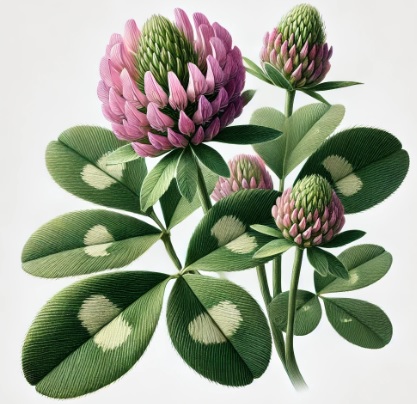Clover (Trifolium pratense), commonly known as Red Clover, is a perennial herbaceous plant in the Fabaceae family. Native to Europe, Western Asia, and North Africa, it is widely cultivated and valued for its medicinal properties and as a forage crop for livestock. It is recognizable by its distinctive trifoliate leaves and pinkish-red flower heads.
Botanical Classification:
Kingdom: Plantae
Order: Fabales
Family: Fabaceae
Genus: Trifolium
Species: Trifolium pratense
Plant Characteristics:
Growth Form: Trifolium pratense is a low-growing perennial herb that typically reaches heights of 30 to 60 cm (12 to 24 inches). It forms a dense rosette of leaves and produces upright flowering stems.
Leaves: The leaves are trifoliate, consisting of three leaflets that are oval to lanceolate, with a characteristic white or pale crescent-shaped mark in the center of each leaflet.
Flowers: The plant produces globular, dense flower heads that are pink to reddish in color. Flowers are small, tubular, and arranged in clusters, blooming from late spring to early summer.
Fruit: The fruit is a small, dry, indehiscent pod that contains several seeds. The seeds are small, brown, and smooth.
Chemical Composition and Structure:
Isoflavones: Red clover is rich in isoflavones, such as genistein, daidzein, and formononetin. These compounds are phytoestrogens that can mimic the effects of estrogen in the body.
Flavonoids: The plant contains flavonoids like quercetin and kaempferol, which have antioxidant properties.
Saponins: Saponins present in red clover are believed to contribute to its medicinal effects and support immune health.
Vitamins and Minerals: Red clover is also a source of vitamins (e.g., vitamin C and B-complex vitamins) and minerals (e.g., calcium, magnesium, and potassium).
How to Cultivate It:
Soil: Red clover prefers well-drained, loamy soil with a pH between 6.0 and 7.0. It can tolerate a range of soil types but thrives in fertile, moist conditions.
Climate: The plant grows well in temperate climates and requires full sun to partial shade. It is tolerant of frost and can withstand cold temperatures.
Watering: Regular watering is necessary to keep the soil moist, especially during dry periods. Ensure proper drainage to avoid waterlogging.
Propagation: Red clover is typically propagated from seeds, which should be sown directly into the soil in early spring or late summer. Seeds should be covered lightly and kept moist until germination.
Maintenance: The plant benefits from periodic mowing or cutting to promote vigorous growth and prevent it from becoming too woody. Red clover can be grown as a cover crop to improve soil fertility.
Uses and Benefits:
Medicinal Uses: Red clover has been traditionally used to support menopausal health due to its phytoestrogen content. It is also used to improve skin health, support respiratory function, and enhance overall vitality. Herbal preparations include teas, tinctures, and capsules.
Culinary Uses: Red clover flowers can be used in salads and herbal teas. They add a mild, sweet flavor and are often used in traditional recipes.
Agricultural Uses: Red clover is commonly used as a forage crop for livestock and as a cover crop to improve soil nitrogen levels and prevent erosion.
Applications:
Herbal Medicine: Red clover is used in herbal medicine for its potential benefits related to hormonal balance, skin health, and respiratory support. It is available in various forms, including teas, capsules, and extracts.
Cosmetics: Extracts from red clover may be included in skincare products for their purported benefits to skin health and their antioxidant properties.
Agriculture: As a forage crop, red clover is valued for its high nutritional content and its ability to enhance soil fertility through nitrogen fixation.
Environmental and Safety Considerations:
Environmental Impact: Red clover is generally considered environmentally beneficial. It enhances soil fertility and supports biodiversity. However, in some areas, it can become invasive and outcompete native plants.
Safety: Red clover is generally safe when used appropriately in culinary and medicinal applications. However, individuals with hormone-sensitive conditions or those on certain medications should consult a healthcare provider before use, as the phytoestrogens in red clover may interact with hormone therapies.
INCI:
Skin conditioning agent. It is the mainstay of topical skin treatment as it has the function of restoring, increasing or improving skin tolerance to external factors, including melanocyte tolerance. The most important function of the conditioning agent is to prevent skin dehydration, but the subject is rather complex and involves emollients and humectants that can be added in the formulation.
Hair conditioning agent. A significant number of ingredients with specific and targeted purposes may co-exist in hair shampoo formulations: cleansers, conditioners, thickeners, matting agents, sequestering agents, fragrances, preservatives, special additives. However, the indispensable ingredients are the cleansers and conditioners as they are necessary and sufficient for hair cleansing and manageability. The others act as commercial and non-essential auxiliaries such as: appearance, fragrance, colouring, etc. Hair conditioning agents have the task of increasing shine, manageability and volume, and reducing static electricity, especially after treatments such as colouring, ironing, waving, drying and brushing. They are, in practice, dispersants that may contain cationic surfactants, thickeners, emollients, polymers. The typology of hair conditioning agents includes: intensive conditioners, instant conditioners, thickening conditioners, drying conditioners. They can perform their task generally accompanied by other different ingredients.
Antioxidant agent. Ingredient that counteracts oxidative stress and prevents cell damage. Free radicals, pathological inflammatory processes, reactive nitrogen species and reactive oxygen species are responsible for the ageing process and many diseases caused by oxidation.
Synonyms:
CAS: 85085-25-2 EC number 285-356-7
![]() Clover
Clover 
